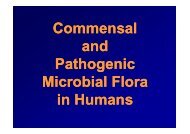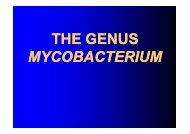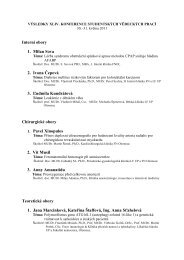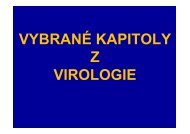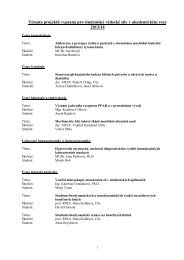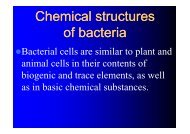THE GENUS STAPHYLOCOCCUS - LF
THE GENUS STAPHYLOCOCCUS - LF
THE GENUS STAPHYLOCOCCUS - LF
You also want an ePaper? Increase the reach of your titles
YUMPU automatically turns print PDFs into web optimized ePapers that Google loves.
<strong>THE</strong> <strong>GENUS</strong><br />
<strong>STAPHYLOCOCCUS</strong>
The genus Staphylococcus contains<br />
about forty species and subspecies<br />
today<br />
Only some of them are important as human<br />
pathogens:<br />
– Staphylococcus aureus<br />
– Staphylococcus epidermidis<br />
– Staphylococcus hominis<br />
– Staphylococcus haemolyticus<br />
– Staphylococcus saprophyticus<br />
– others
Staphylococci are gram-positive<br />
cocci, 0.5 to 1.5<br />
mikrometer in diameter, nonmotile, nonsporeforming,<br />
facultatively anaerobic.<br />
The name Staphylococcus is derived from the Greek<br />
term „staphyle<br />
staphyle“,<br />
meaning „a bunch of grapes“.<br />
This<br />
name refers to the fact that the cells of these gram-<br />
positive cocci grow in a pattern resembling a cluster of<br />
grapes. However, microorganisms in clinical material<br />
may also appear as single strain, pairs, or short chains.
Physiology and structure<br />
Capsule or polysaccharide slime layer<br />
Peptidoglycan layer<br />
Teichoic acid<br />
Protein A<br />
Cytoplasmatic membrane<br />
Clumping factor<br />
Cytoplasma
Capsule or polysaccharide slime layer<br />
A loose-fitting, polysaccharide layer (slime layer) is only<br />
occasionally found in staphylococci cultured in vitro, but is<br />
believed to be more commonly present in vivo.<br />
Eleven capsular serotypes have been identified in S. aureus,<br />
with serotypes 5 and 7 associated with majority of<br />
infections.<br />
The capsule protects the bacteria by inhibiting the<br />
chemotaxis and phagycotosis of staphylococci by<br />
polymorphonuclear leukocytes, as well as by inhibiting the<br />
proliferation of mononuclear cells.<br />
It is also facilitates the adherence of bacteria to catheters<br />
and other synthetic material.
Protein A<br />
The surface of most S. aureus strains (but not the coagulasenegative<br />
staphylococci) is uniformly coated with protein A.<br />
This protein is covalently linked to the peptidoglycan layer<br />
and has a unique affinity for binding to the Fc receptor of<br />
immunoglobulin IgG.<br />
The presence of protein A has been exploited in some<br />
serological tests, in which protein A-coated S. aureus is<br />
used as a nonspecific carrier of antibodies directed against<br />
other antigens.<br />
Additionally, detection of protein A can be used as a<br />
specific identification test for S. aureus.
Peptidoglycan<br />
Half of the cell wall by weight is peptidoglycan, a<br />
feature common to gram-positive bacteria.<br />
The subunits of peptidoglycan are N-acetylmuramic<br />
acid and N-acetylglucosoamine.<br />
Unlike gram-negative bacteria, the peptidoglycan<br />
layer in gram-positive bacteria consists of many<br />
cross-linked layers, which makes the cell wall more<br />
rigid.
Teichoic acid<br />
Teichoic acid is species-specific, phosphatecontaining<br />
polymers that are bound covalently to the<br />
peptidoglycan layer or through lipophilic linkage to<br />
the cytoplasmic membrane (lipoteichoic acid).<br />
Teichoic acid mediates the atachment of<br />
staphylococci to mucosal surfaces through its<br />
specific binding to fibronectin.
Coagulase and other surface proteins<br />
The outer surface of most strains of S. aureus contains<br />
clumping factor (also called bound coagulase).<br />
This protein binds fibrinogen, converts it to insoluble fibrin,<br />
causing the staphylococci to clump or aggregate.<br />
Detection of this protein is the primary test for identifying<br />
S. aureus.<br />
Other surface proteins that appear to be important for<br />
adherence to host tissues include:<br />
– collagen-binding protein<br />
– elastin-binding protein<br />
– fibronectin-binding protein
Cytoplasmic membrane<br />
•The cytoplasmic membrane is made up of a<br />
complex of proteins, lipids, and small<br />
amount of carbohydrates.<br />
•It serve as an osmotic barrier for the cell and<br />
provides an anchorage for the cellular<br />
biosynthetic and respiratory enzymes.
Staphylococcal toxins<br />
S. aureus produces many virulence factors, including at least<br />
five cytolytic or membrane-damaging toxins:<br />
– alpha toxin<br />
– beta toxin<br />
– delta toxin<br />
– gamma toxin<br />
– Panton-Valentin toxin<br />
– two exfoliative toxins<br />
– eigth enterotoxins (A-E, G-I)<br />
– Toxic Shock Syndrome Toxin 1 (TSST-1)<br />
The enterotoxins and TSST-1 belong to a class of polypeptide<br />
known as superantigens.<br />
Staphylococcus aureus strains produce several other<br />
extracellular, biologically active substances, including proteases,<br />
phosphatases, lipases, lysozyme etc.
Exfoliative toxins<br />
Staphylococcal scalded skin syndrome<br />
(SSSS), a spectrum of diseases characterized<br />
by exfoliative dermatitis, is mediated by<br />
exfoliative toxins.<br />
The prevalence of toxin production in<br />
S. aureus strains varies geographically but is<br />
generally less than 5% to 10%.
Enterotoxins<br />
Eigth serologically distinct staphylococcal<br />
enterotoxins (A-E, G-I) and three subtypes of<br />
enterotoxin C have been identified.<br />
The enterotoxins are stable to heating at 100<br />
°C for 30 minutes and are resistant to<br />
hydrolysis by gastric and jejunal enzymes.
Enterotoxins<br />
Thus, once a food product has been contaminated with<br />
enterotoxin-producing staphylococci and the toxin have<br />
been produced, neither reheating the food nor the digestive<br />
process will be protective.<br />
These toxins are produced by 30% to 50% of all S. aureus<br />
strains.<br />
Enterotoxin A is most commonly associated with disease.<br />
Enterotoxins C and D are found in contamined milk<br />
products, and enterotoxin B causes staphylococcal<br />
pseudomembranous enterocolitis.
Toxic Shock Syndrome Toxin - 1<br />
TSST-1, formerly called pyrogenic exotoxin C and<br />
enterotoxin F, is a heat and proteolysis resistant,<br />
chromozomally mediated exotoxin.<br />
The ability of TSST-1 to penetrate mucosal barriers,<br />
even though the infection remains localized in the<br />
vagina or at the site of a wound, is responsible for<br />
the systemic effects of TSS.<br />
Death in patients with TSS is due to hypovolemic<br />
shock leading to multiorgan failure.
Staphylococcal enzymes<br />
–Coagulase<br />
–Catalase<br />
–Hyaluronidase<br />
–Fibrinolysin<br />
–Lipases<br />
–Nuclease<br />
–Penicillinase
Coagulase<br />
S. aureus strains possess two forms of coagulase:<br />
– bound,<br />
– free.<br />
Coagulase bound to the staphylococcal cell wall can directly<br />
convert fibrinogen to insoluble fibrin and cause the<br />
staphylococci to clump.<br />
The cell-free coagulase accomplishes the same result by reacting<br />
with a globulin plasma factor.<br />
The role of coagulase in the pathogenesis of disease is<br />
speculative, but coagulase may cause the formation of fibrin<br />
layer around a staphylocccal abscess, thus localizing the<br />
infection and protecting the organisms from phagocytosis.
Catalase<br />
•All staphylococci produce catalase, which<br />
catalyzes the conversion of toxic hydrogen<br />
peroxide to water and oxygen.<br />
•Hydrogen peroxide can accumulate during<br />
bacterial metabolism or after phagycytosis.
Hyaluronidase<br />
•Hyaluronidase hydrolyzes hyaluronic acid,<br />
the acidic mucopolysaccharides present in<br />
the acellular matrix of connective tissue.<br />
•This enzyme facilitates the spread of<br />
S. aureus in tissues.<br />
•More than 90% of S. aureus strains produce<br />
this enzyme.
Fibrinolysin<br />
•Fibrinolysin, also called staphylokinase, is<br />
produced by virtually all S. aureus strains<br />
and can dissolve fibrin clots.<br />
•Staphylokinase is distinct from the<br />
fibrinolytic enzymes produced by<br />
streptococci.
Epidemiology<br />
Staphylococci are ubiquitous. All persons have coagulasenegative<br />
staphylococci on their skin, and transient<br />
colonization of moist skin folds with S. aureus is common.<br />
Colonization of the umbilical stump, skin and perineal area<br />
of neonates with S. aureus is common.<br />
S. aureus and coagulase-negative staphylococci are also<br />
found in the oropharynx, gastrointestinal and urogenital<br />
tract.<br />
Because staphylococci are found on the skin and in the<br />
nasopharynx, shedding of the bacteria is common and is<br />
responsible for many hospital-acquired infections.
The genus Staphylococcus can be<br />
divided into two subgroups<br />
(on the basis of its ability to clot blood<br />
plasma by enzyme coagulase):<br />
coagulase-positive<br />
coagulase-negative
Subgroup of coagulase-positive species<br />
contains from human staphylococci only<br />
one species<br />
– Staphylococcus aureus<br />
<br />
Other coagulase-positive species are<br />
animal staphylococci<br />
– e.g. Staphylococcus intermedius
Subgroup of coagulase-negative<br />
species contains from human<br />
staphylococci:<br />
– Staphylococcus epidermidis,<br />
– Staphylococcus hominis,<br />
– Staphylococcus haemolyticus,<br />
– Staphylococcus saprophyticus,<br />
– Staphylococcus simulans,<br />
– Staphylococcus warneri and other.
The species Staphylococcus aureus<br />
Morphology<br />
– Gram-positive, spherical cells, mostly arranged in irregular<br />
grape like clusters.<br />
– Polysaccharide capsule is only rarely found on cells.<br />
– The peptidoglycan layer is the major structural component of<br />
the cell wall. It is important in the pathogenesis of<br />
staphylococcal infections. Other important component of cell<br />
wall is teichoic acid.<br />
– Protein A is the major protein component of the cell wall. It is<br />
located on the cell surface but is also released into the culture<br />
medium during the cell growth. A unique property of protein<br />
A is its ability to bind to the Fc part of all IgG molecules<br />
except IgG3. It is not an antigen-antibody specific reaction.
The species Staphylococcus aureus<br />
culture characteristics<br />
Colonies on solid media are round, regular, smooth,<br />
slightly convex and 2 to 3 mm in diameter after 24h<br />
incubation.<br />
Most strains show a β-hemolysis surrounding the<br />
colonies on blood agar.<br />
S. aureus cells produce cream, yellow or orange<br />
pigment.
The species Staphylococcus aureus<br />
resistance<br />
Like most of medical important non-spore-forming<br />
bacteria, S. aureus is rapidly killed by temperature<br />
above 60 °C.<br />
S. aureus is susceptible to disinfectants and<br />
antiseptics commonly used.<br />
S. aureus can survive and remain virulent long<br />
periods of drying especially in an environment with<br />
pus.
The species Staphylococcus aureus<br />
pathogenicity<br />
S. aureus is pathogenic for human as well as for all domestic and<br />
free-living warm-blooded animals.<br />
S. aureus causes disease through the production of toxin or<br />
through direct invasion and destruction of tissue.<br />
The clinical manifestations of some staphylococcal diseases are<br />
almost exclusively the result of toxin activity (e.g.<br />
staphylococcal food poisoning and TSS), whereas other diseases<br />
result from the proliferation of the staphylococci, leading to<br />
abscess formation and tissue destruction (e.g. cutaneous<br />
infection, endocarditis, pneumonia, empyema, osteomyelitis,<br />
septic arthritis).
Clinical diseases<br />
Staphylococcal pyogenic infections:<br />
– folliculitis,<br />
– furuncle,<br />
– carbuncle,<br />
– bullous impetigo,<br />
– panaritia and paronychia,<br />
– wound infections,<br />
– mastitis,<br />
– osteomyelitis,<br />
– staphylococcal pneumonia and other.
Clinical diseases<br />
Stahylococccal intoxications:<br />
– staphylococcal food poisoning (enterotoxicosis),<br />
– exfoliative intoxications (Ritter´s disease or<br />
SSSS),<br />
– staphylococcal toxic shock syndrome (TSS).
Treatment<br />
Antistaphylococcal antibiotics of the first choice:<br />
– oxacillin (methicillin)<br />
– cephalosporins of I. generation (cefazolin, cephalotin)<br />
Antistaphylococcal antibiotics of the second choice:<br />
– lincosamides (e.g. clindamycin)<br />
– glycopeptides (vancomycin, teicoplanin)<br />
– linezolid<br />
– tigecyklin<br />
– daptomycin<br />
– and others
Resistance of S. aureus to oxacillin<br />
in University hospital Olomouc<br />
S.<br />
aureus 2005 2006 2007 2008 2009 2010<br />
OXA<br />
5.9<br />
(1522)<br />
6.9<br />
(1620)<br />
2.3<br />
(1735)<br />
3.0<br />
(1749)<br />
0.9<br />
(1642)<br />
0.3<br />
(2403)
Diagnosis<br />
Microscopy – smears of clinical materials are<br />
stained according to Gram.<br />
Cultivation on solid media (usually blood<br />
agar).<br />
Biochemical tests.<br />
Phage typing – susceptibility of S. aureus<br />
strains to various temperature phages.
Peptococcus species<br />
Members of the genus Peptococcus are strictly anaerobic<br />
cluster-forming gram-positive cocci.<br />
These microorganisms grow only under anaerobic<br />
conditions.<br />
They are part of the normal microflora of the mouth, upper<br />
respiratory tract, bowel, and female genital tract.<br />
They often participate with many other bacterial species in<br />
mixed anaerobic infections in the abdomen, pelvis, lung, or<br />
brain.
Related microorganisms<br />
The genus Micrococcus<br />
– Micrococcus luteus<br />
– Micrococcus lylae<br />
Both species are found in nature and colonize humans,<br />
primarily on the surface of the skin.<br />
Although micrococci may be found in patients with<br />
opportunistic infections, their isolation in clinical specimen<br />
usually represents clinically insignificant contamination<br />
with skin flora.
Related microorganisms<br />
The genus Stomatococcus<br />
– Stomatococcus mucilaginosus, the only species in this<br />
genus, is a commensal microorganism that resides in the<br />
oropharynx and upper respiratory tract.<br />
In recent years, this microorganism has been<br />
reported to be the cause of an increasing number of<br />
opportunistic infections (endocarditis, septicemia,<br />
catheter-related infections) in immunocompromised<br />
patients.





